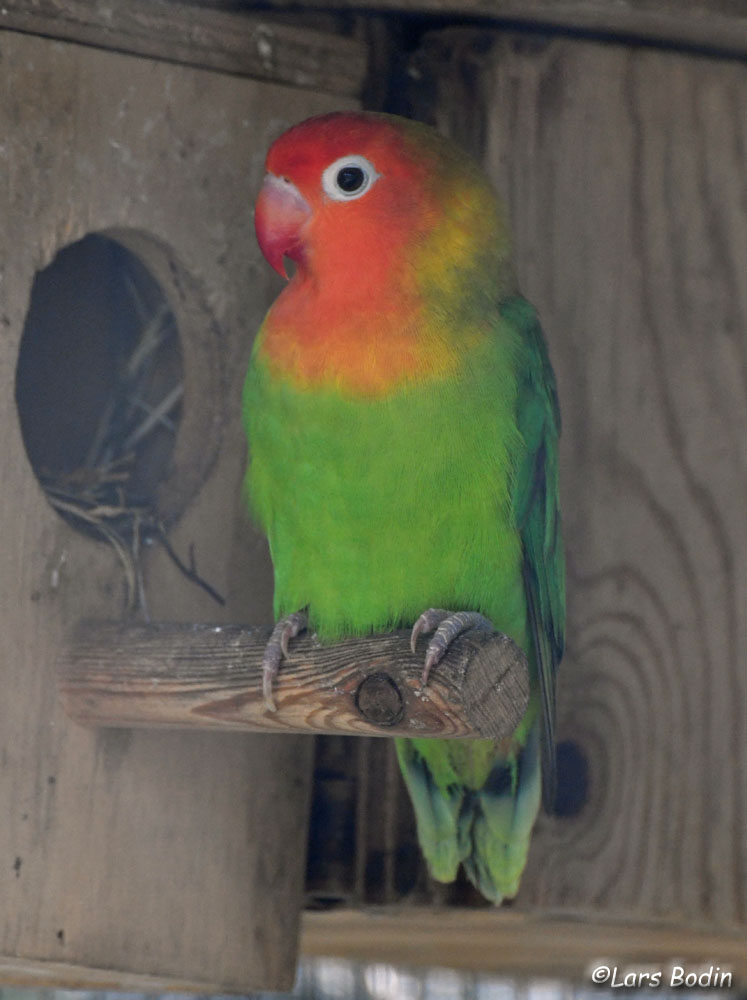Agapornis lilianae - Lilian's Lovebird
Lilian’s Lovebird – Agapornis lilianae (Shelley, 1894) – is one of the smallest Lovebirds measuring only about 13 cm. It is more difficult to breed in captivity and not as common as domestic bird compared to other Lovebird species.
Lovebirds can be quite noisy but in spite of that they are very popular as domestic birds due to the small size, beautiful colors and a very social and curious mind. They are not as good at talking as other parrots, but can learn to say individual words.
They are very social and require much attention – if they are not stimulated they may start picking their feathers or get other mental problems. It is recommended to keep a single pet Lovebird but instead have a pair – that will ensure they get the company and social stimulation this specie require.
They are very intelligent and curious birds who love to explore their surroundings – be careful that there are no places where they may end up stuck. Also make sure that the door can not be opened just by pushing the door, otherwise they may run away.
According to the IUCN Red List Lilian’s Lovebird is Near Threated because of a moderately small population of wild birds. They are listed on CITES Appendix II and EU Annex B.
Description
The plumage is green with orange on the head as well as the upper part of the chest. The rump is green. Naked white skin around the eye (eyering).
The male and female have the same colors.
Size: 13 cm
Looks similar to:
- For the untrained eye Lilian’s Lovebird may be confused with Fischer’s Lovebird (Agapornis fischeri), which is slightly larger and has olive green head.
- Lilian’s Lovebird may also be confused with the more common Rosy-faced Lovebird (Agapornis Roseicollis), which has a more distinctly delimited orange color and lacks the white eye.
Subspecies
None.
Habitat
Africa: From Tanzania to Zimbabwe and Mozambique
Diet
Wild birds feed on grass seeds, millet, wild rice and various other seeds, flowers and fruits.
Aviculture
They have a gentle mind and can be kept together with other birds without trouble. However they are difficult to breed in captivity.
The female lay 3 to 8 white eggs, which are incubated for about 22 days. The young chicks leave the nest about 44 days after hatching.
Taxonomy
- Order: Psittaciformes
- Family: Psittaculidae
- Genus: Agapornis
Synonyms
- Danish: Jordbærhovedet Dværgpapegøje
- English: Lilian’s Lovebird, Nyasa Lovebird, Nyassa Lovebird
- French: Inséparable de Liliane, Inséparable nyasa
- German: Erdbeerköpfchen
- Portuguese: Inseparável do Niassa, Inseparável-de-niassa
- Spanish: Inseparable del Nyasa, Inseparable Liliana
- Scientific: Agapornis lilianae
IUCN Red List

BirdLife International 2018. Agapornis lilianae. The IUCN Red List of Threatened Species 2018: e.T22685356A131916985.
https://dx.doi.org/10.2305/IUCN.UK.2018-2.RLTS.T22685356A131916985.en
Downloaded on 9 July 2021

